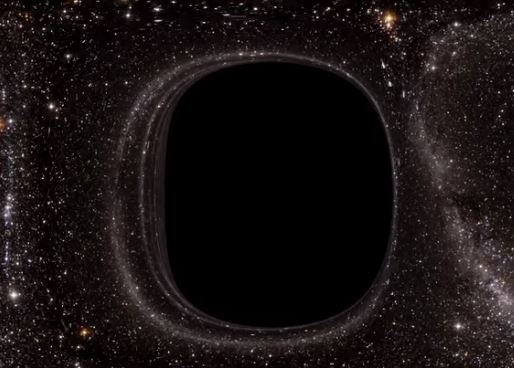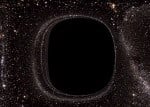The visual-effects team involved in making Christopher Nolan’s epic Oscar-nominated movie Interstellar have provided new insights into the powerful effects of black holes, turning science fiction into science fact.
In a paper published in the journal Classical and Quantum Gravity (citation below), the scientists describe the computer code they used to generate the film’s iconic images of the wormhole, black hole and several celestial bodies.
The Interstellar visual-effects team, consisting of London-based firm Double Negative and Caltech theoretical physicist Kip Thorne, also explained how their innovative code has led them to new sciencific discoveries.

View of a starfield under the influence of gravitational lensing. (Image: Double Negative)
They found that when a camera is up close to a fast-spinning black hole, the caustics (peculiar surfaces in space) create over a dozen images of individual stars of the bright, thin plane of the galaxy in which the black hole exists.
The images, they said, are concentrated along one edge of the black hole’s shadow.
The multiple images occur when the black hole drags space into a whirling motion and stretches the caustics around itself several times.
What would people near a black hole see?
Never before have the effects of caustics been computed for a camera close to a black hole. The images give scientists some idea of what a human would see if they were in orbit around a hole.
The team’s computer code mapped the paths of millions of light beams and their evolving cross-sections as they went through the black hole’s warped spacetime, thus making the discovery possible.
Thanks to their computer code, the team had been able to create images of the movie’s wormhole and black hole, Gargantua, and its glowing accretion disk, with amazing clarity and smoothness.
An accretion disk is a flat, disk-like gas structure that rapidly spirals around a larger object, such as a black hole, a white dwarf or a new star.
It showed parts of the accretion disk swinging up over the top and down below Gargantua’s shadow, and in front of the shadow’s equator as well, producing a picture of a split shadow that has become a hallmark for the movie.
Distortion caused by gravitational lensing
The glowing disc’s mysterious distortion was caused by gravitational lensing – when the light from a very bright and distant objected is distorted around a block hole between the viewer and the bright object – before they arrive at the movie’s simulated camera. Gravitational lensing was predicted by Einstein in his theory of general relativity.
This lensing occurs because the black hole creates a very powerful gravitational field, it literally bends the fabric of spacetime around itself, like a bowling ball lying on a taut bed sheet.
Earlier on, while making the movie, with the black hole encircled with a rich field of faraway stars and nebulae instead of an accretion disk, the visual-effects team found that the standard approach of using simply one light ray for one pixel in a computer code – which in this case was for an IMAX picture, a total of 23 million pixels – resulted in flickering as nebulae and stars across the screen.
Video – Gravitational lensing by spinning black holes
Oliver James, chief scientist at Double Negative, said:
“To get rid of the flickering and produce realistically smooth pictures for the movie, we changed our code in a manner that has never been done before. Instead of tracing the paths of individual light rays using Einstein’s equations–one per pixel–we traced the distorted paths and shapes of light beams.”
Co-author Kip Thorne said:
“This new approach to making images will be of great value to astrophysicists like me. We, too, need smooth images.”
DNGR could be adapted for scientific research
Mr. James continued:
“Once our code, called DNGR for Double Negative Gravitational Renderer, was mature and creating the images you see in the movie Interstellar, we realized we had a tool that could easily be adapted for scientific research.”
The team used DNGR to perform several research simulations exploring the influence of caustics on the images of distant star fields as seen by a camera close to a spinning black hole.
Mr. James said:
“A light beam emitted from any point on a caustic surface gets focussed by the black hole into a bright cusp of light at a given point. All of the caustics, except one, wrap around the sky many times when the camera is close to the black hole.”
“This sky-wrapping is caused by the black hole’s spin, dragging space into a whirling motion around itself like the air in a whirling tornado, and stretching the caustics around the black hole many times.”
As a caustic passes a star, it either creates two new images of the star as captured by the camera, or eliminates two old images of the star. As the camera orbited the black hole, DNGR simulation film clips showed that the caustics were continuously creating and eliminating a huge number of stellar images.
The team spotted up to 13 simultaneous images of the same star, and as many as 13 images of the bright, thin plane of the galaxy in which the black hole exists.
These multiple images were only created when the black has was spinning fast and only on the near side of the black hole, where its whirling space was moving in the direction of the camera, which they deduced was due to the space ‘flinging’ the images outward from the hole’s shadow edge.
On the opposite side of the shadow, where space was whirling away from the camera, the scientists deduced that although there were multiple images of each star, the whirl of space had compressed them inward, so close to the black hole’s shadow that they were not visible in the simulations.
Citation: “Gravitational lensing by spinning black holes in astrophysics, and in the movie Interstellar,” Oliver James, Eugénie von Tunzelmann, Paul Franklin and Kip S Thorne. Classical and Quantum Gravity 32 065001. doi:10.1088/0264-9381/32/6/065001.
Video – Starfield under the influence of gravitational lensing

